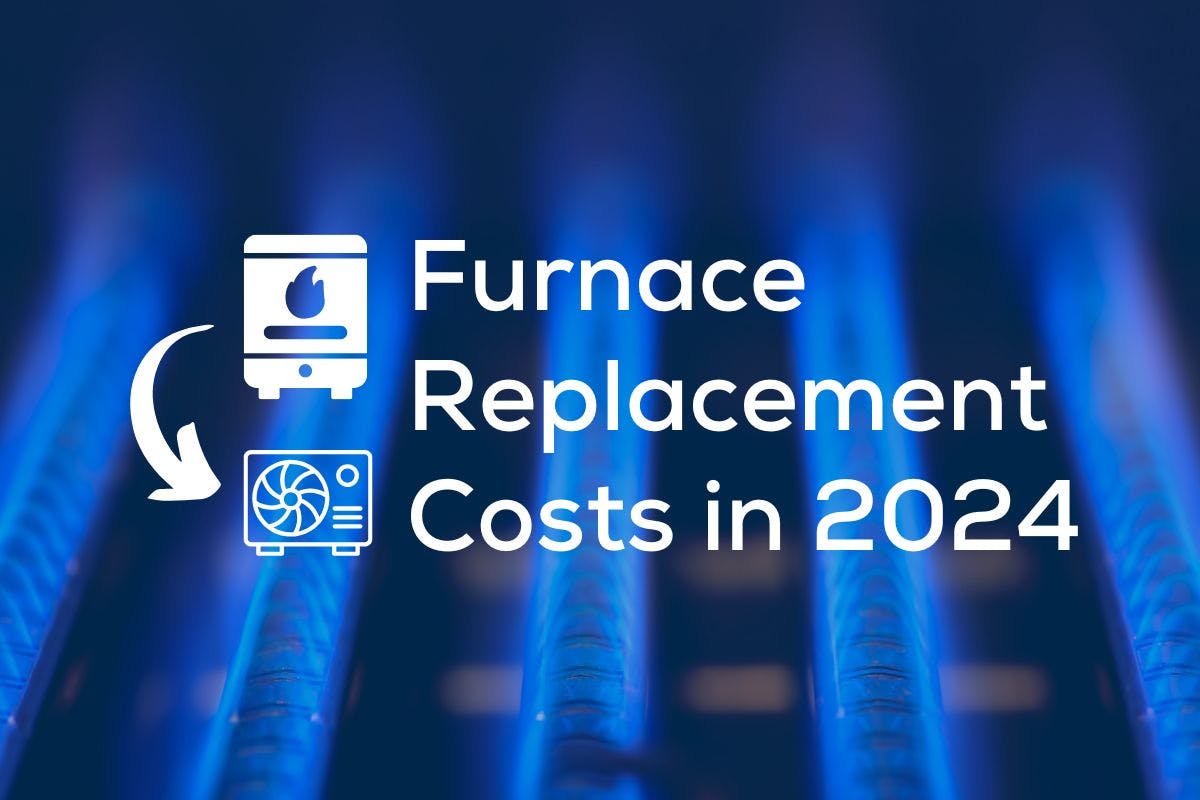When your home’s furnace reaches its end, it’s a problem and expense no one wants. Nonetheless, comparing types of furnaces, and looking into factors such as energy efficiency and financial incentives could help you save money and find a more energy efficient option like a heat pump.
Choosing the best home HVAC system can cut your energy bills and keep you comfortable all year long. Here’s what you need to know about home heating options, the estimated cost, and tax credits or incentives.
See how much you can save with home energy changes
Different Kinds of Furnaces
There are electric, natural gas, oil, and propane furnaces, as well as electric heat pumps. The right choice for your home depends on a number of factors, including whether your have home solar panels or want to electrify your home. Each furnace type has pros and cons.
Electric furnaces
Electric furnaces use heat coils to heat air, which is then sent through ducts and vents throughout a home.
Electric furnaces typically have lower upfront purchase and installation costs than gas or oil furnaces, and they generally require less maintenance over their lifespan.
Electric furnaces are efficient but not as efficient as heat pumps. Pairing one with solar power could cover some of the operating costs.
Electric furnaces can have slower heat output and might not be a powerful enough or efficient solution for colder winter climates.
Electric heat pump
While not technically a furnace, heat pumps can heat and cool your home efficiently. While heat pumps (somewhat unfairly) received a reputation of poor work in cold weather, improved technology is making modern heat pumps better at lower temperatures. Some cold climate heat pumps built to heat your home at their full capacity down to 5 degrees Fahrenheit and can keep you warm well below that.
Current heat pumps can reduce your electricity use for heating by up to 75% compared to electric furnaces.
The upfront expense of a new heat pump is a consideration, but tax credits can help bring the upfront cost down, and heat pump leasing is increasingly available. Heat pumps outsold gas furnaces in 2022, 2023, and 2024.
Gas furnaces
Oil, gas, and propane heating are common in colder areas, like New England, the Great Lakes states, the Northern Plains, and the Rocky Mountains. The price of fuel can fluctuate, and switching from an oil or propane heater to a heat pump can deliver some of the largest savings. Even with cheap natural gas, many Americans could save by switching the Department of Energy says.
The cons of gas furnaces include the need for more maintenance and cleaning. Burning fossil fuels can generate greenhouse gases and harm the air quality in your home.
See what home electrification can do for you:
When Should You Replace a Furnace?
Electric furnaces have a lifespan of 20-30 years. Propane and gas furnaces range from 15-30 years. Oil furnaces average about 15-20 years.
The most obvious sign of a dying furnace is not enough heat. You could also experience different temperatures in some rooms or areas of your home.
Even if the furnace is keeping up with your heating needs, it might need to run more often and use more energy to keep up with your thermostat setting, resulting in higher energy bills.
Grinding, banging, rattling, rumbling, or clicking could mean something mechanical is about to be a major, expensive problem. If your furnace needs increasing and increasingly expensive repairs, it’s a sign a new unit may be the wiser investment.
Bad air quality, especially with gas, oil, or propane systems, could signal it’s time to can your furnace. Exhaust from these furnaces should go outside, but the smell of fumes could mean your furnace is about to die.
More humidity and more dust are also potential signs of an old furnace.
Replacing a Furnace With a Heat Pump
For financial, comfort, and environmental reasons, you might switch from a furnace to a heat pump for heating and cooling. In the summer, a heat pump cools your house by moving heat outside, like an air conditioner. In the winter, the heat pump simply moves heat from the outdoor air indoors.
Heat pumps can cut your energy consumption for heating by about 75% compared to an electric furnace.
The most obvious downside with a heat pump is the upfront expense. However, if it’s the right system for your heating and cooling needs year-round the cost could make more sense. The Energy Efficient Home Improvement Credit can help bring down the cost of a heat pump and rebates from state-run programs are coming online.
Another possible drawback of an electric heat pump was its ability to handle the cold, but new cold-climate heat pumps perform reliably in temperatures down to 5 degrees Fahrenheit.
Replacement Costs for Furnaces
There’s not one easy answer to how much a furnace costs.
The size of your house and your area’s climate are a couple of big variables. Buying a high-efficiency furnace of any fuel type will generally cost more upfront but should give you energy savings in the long run.
Are you changing fuel type? Will you need different or updated permitting? Labor costs in your area, removal of the old furnace, and work on ducts or other components if your system requires it can change the cost of a new system.
| Type of heat system | Price range (purchase and installation) |
|---|---|
| Electric furnace | $1,800-$7,300 |
| Electric heat pump | $7,500-$20,000 |
| Gas furnace | $2,800-$10,000 |
| Oil furnace | $4,500-$10,000 |
| Propane furnace | $3,700-$14,200 |
Price estimates based on a survey of online consumer resources.
Rebates, Tax Credits, and Incentives
There are federal, state, and local tax credits, rebates, and other incentives for new furnaces and heat pumps, particularly those certified by Energy Star for energy efficiency, that may be available to you. These incentives bring down the upfront cost.
New electric heat pumps may qualify for tax credits up to $2,000 in a year, also in the Energy Efficiency Home Improvement Tax Credit. For more details, check the IRS requirements and the Department of Energy’s guide to tax credits and rebates. North Carolina State University’s Database of State Incentives for Renewables and Efficiency collects other state and local incentives that may apply.
Your utility company, a reputable local business, or Palmetto can work with you and answer your questions to maximize your savings from federal, state, and local incentives. Everyone’s tax situation is different, so always check with your tax advisor about your eligibility.
See how much you can save with home energy changes
Professional Furnace Replacement Process
Picking a professional to install a new furnace (and remove the old furnace) is almost always the best decision. Along with the installation itself, a professional installer will do the following.
- Do an onsite inspection and assessment.
- Help you choose the best new furnace or heat pump, considering your needs, budget, and efficiency.
- Remove the old furnace and components.
- Inspect and repair ducts for safety and efficiency.
- Install the new furnace.
- Test, check, and inspect the new system.
- Walk you through its use and answer all your questions.
DIY Furnace Replacement Process
Most states require a permit to install, replace, and do certain repairs or maintenance on a furnace or HVAC system. So, unless you’re a licensed professional, you should not install a furnace as a DIY job. It could actually be illegal.
Working with gas, electricity, oil, propane, fumes, and chemicals can also be a safety hazard. An improperly installed furnace can be about 30% less efficient than a properly installed one and will likely require repair anyway. You will likely void a warranty by installing a furnace or heat pump yourself.
See what home electrification can do for you:
Frequently Asked Questions
When should I replace my furnace?
There are several signs it’s time to replace your furnace. Loss of heating power, unequal heating throughout your home, a furnace running nearly constantly, higher energy bills, strange sounds, and bad odors or fumes are some potential problems with an old furnace.
What is a heat pump?
A heat pump uses outdoor air as the heating or cooling source, moving heat inside or out depending on the season. In the summer, a heat pump moves heat from inside to outside, cooling the air in your home like an air conditioner. In the winter, the heat pump takes heat from the outdoor air and uses it to heat your house.
What is a cold-climate heat pump?
New cold-climate heat pumps are built to work efficiently in very cold temperatures, to 5 degrees or colder. If you live where a heat pump might not have been an option in the past, you may consider a cold-climate heat pump with an Energy Star Cold Climate certification.
How long should a furnace last?
Current furnaces should last 15-30 years with proper maintenance.
Disclaimer: This content is for educational purposes only. Palmetto does not provide tax, legal, or accounting advice. Please consult your own tax, legal, and accounting advisors.
 Andrew GiermakWriter and Editor
Andrew GiermakWriter and EditorAndrew joined Palmetto in Charlotte in August 2024. He’s been a writer in journalism, then in business, going back to almost the 20th century. He’s lived in Indiana, Virginia, Pennsylvania, Virginia again, and now North Carolina for the last 12 years. He likes golf. Is he good at it? Not so much.

